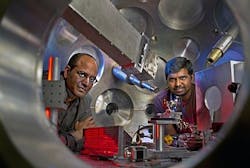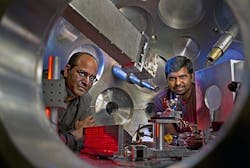Terawatt laser sheds light on laser-plasma interaction for cancer therapy development
Scientists at the Los Alamos National Laboratory (LANL; Los Alamos, NM) have observed for the first time how a laser penetrates dense, electron-rich plasma to generate ions. The process has applications for developing next-generation particle accelerators and new cancer treatments.
The results of the work also confirms predictions made more than 60 years ago about the fundamental physics of laser-plasma interaction. Plasmas dense with electrons normally reflect laser light like a mirror. But a strong laser can drive those electrons to near the speed of light, making the plasma transparent and accelerating the plasma ions.
The team, which also included researchers from the Max Planck Institute for Quantum Optics (Garching, Germany) and Queens University (Belfast, Northern Ireland) used the 200 terawatt (TW) short-pulse Trident laser at LANL to observe the transparency phenomenon at 50 fs resolution. Until now, those dynamics have been witnessed only in computer simulations.
The team found close agreement between the model and their experiments, which confirms that directing a short-pulse laser at a very thin carbon foil target will make the foil transparent to the laser.
âIn a sense it also validates the simulation code that researchers have been using for some time,â says Sasi Palaniyappan of LANLâs plasma physics group. âAt the same time it also tells us that weâre doing an experiment thatâs as close as possible to simulation.â
The results will help advance work to control the shape and timing of laser pulses, precision that is necessary for developing next-generation, laser-driven particle accelerators, he says. The researchers have recently been awarded internal laboratory funding from the office of Laboratory Directed Research and Development (LDRD) to pursue these applications.
They now plan to add a second foil target, which could benefit from further focusing and faster turn-on of the laser light transmitted through the first foil. One application of the resulting ultra-short ion bunches is to rapidly heat material and study the ensuing dynamics.
Particles accelerated by conventional accelerators arenât fast enough for such physics experiments. Also, energetic ions are applicable to cancer therapy. A more compact, laser-driven ion source would make treatment less expensive and more accessible to patients.
The work has been published in Nature Physics; for more information, please visit http://dx.doi.org/10.1038/NPHYS2390.
-----
Follow us on Twitter, 'like' us on Facebook, and join our group on LinkedIn
Laser Focus World has gone mobile: Get all of the mobile-friendly options here.
Subscribe now to BioOptics World magazine; it's free!

